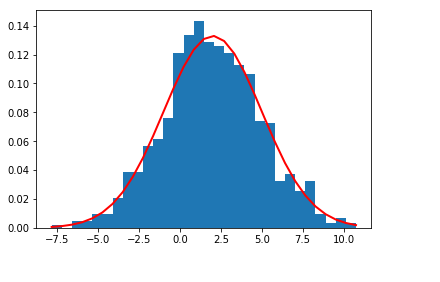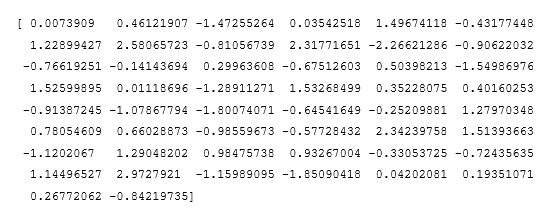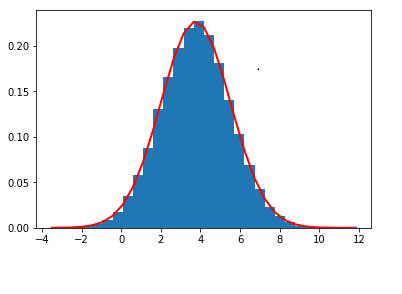#导包 import numpy as np #导入鸢尾花数据 from sklearn.datasets import load_iris data = load_iris() pental_len = data.data[:,2] print(pental_len) #计算尾花花瓣长度的最大值,平均值,中值,均方差 print("最大值:",np.max(pental_len)) print("平均值:",np.mean(pental_len)) print("中值:",np.median(pental_len)) print("均方差:",np.std(pental_len)) #用np.random.normal()产生一个正态分布的随机数组,并显示出来 #正态分布 import numpy as np import matplotlib.pyplot as plt mu = 2 #期望为2 sigma = 3 #标准差为3 num = 1000 #个数为10000 rand_data = np.random.normal(mu, sigma, num) count, bins, ignored = plt.hist(rand_data, 30, normed=True) plt.plot(bins, 1/(sigma * np.sqrt(2 * np.pi)) *np.exp( - (bins - mu)**2 / (2 * sigma**2)), linewidth=2, color='r') plt.show() #np.random.randn()产生一个正态分布的随机数组,并显示出来 Data=np.random.randn(50) print(Data) #显示鸢尾花花瓣长度的正态分布图,曲线图,散点图 #正态分布图 import numpy as np import matplotlib.pyplot as plt mu=np.mean(pental_len) sigma=np.std(pental_len) num=99999 rand_data = np.random.normal(mu,sigma,num) count, bins, ignored = plt.hist(rand_data, 30, normed=True) plt.plot(bins, 1/(sigma * np.sqrt(2 * np.pi)) *np.exp( - (bins - mu)**2 / (2 * sigma**2)), linewidth=2, color='r') plt.show() #曲线图# plt.plot(np.linspace(1,150,num=150),pental_len,'c') plt.show() #散点图# plt.scatter(np.linspace(0,150,num=150),pental_len,alpha=0.5,marker='4') plt.show()





